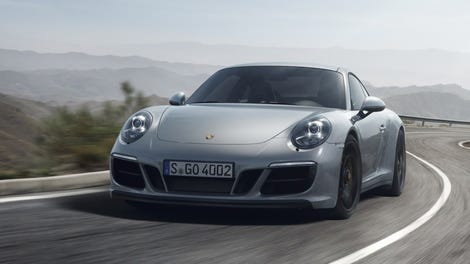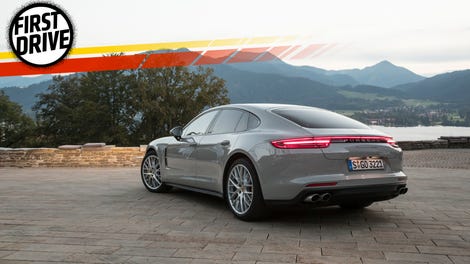I’m conflicted. A few months ago my good friend and fellow Nürburgring resident Dale Lomas wrote a review of the all-new 2017 Porsche Panamera. He said, and I quote, “The truth is that there’s a certain proportion of us who will never, ever, consider buying one. Because it’s not a ‘real’ Porsche, and it’s just not exciting enough to ever be a real Porsche.” Ouch.
At the time I hadn’t driven the new Panamera, and so based on that lack of experience with the car I couldn’t form an opinion of Dale’s review. However I had driven the previous generation car and found that, in spite of its—how do I be charitable here, less than attractive appearance—it was an incredibly capable and fast sedan, and worthy of the Porsche name.
Advertisement
Advertisement
Dale’s main premise was that it wasn’t hardcore enough to be a Porsche, and I took issue with that. If the people at Porsche build a car, it’s a Porsche, no? To me that’s like saying because an Audi A3 isn’t as hardcore as an Audi R8 V10 Plus, it’s not a “real” Audi.
It doesn’t seem fair to me.
So while the trip down to South Africa was mainly to test the new 911 GTS, which you will read soon I was also quite keen to drive the Panamera for myself and see what all the fuss—or lack thereof—was about.
Sponsored
(Full Disclosure: Porsche wanted me to drive the new Panamera 4 E-Hybrid so bad they offered to let me fly 38 hours and 3 layovers down to the southernmost tip of Africa to drive a left-hand drive car in a right-hand drive country. Which, as I found out, is not the recommended cure for jet lag.)
Ever-Improving Looks
While I thought the original Panamera drove like a proper sports sedan, I would never have brought one solely because of it appearance, of which I was not a fan. Let’s be real, who was? The original car looked like it was made to be the target of every single “Yo Mama” joke you ever heard on the playground as a kid: I’ll go with “it fell out of the ugly tree and hit every branch on the way down.” I’ll also add that it then fell through an ugly hole at the base of that tree and hit all the ugly roots as well.
Advertisement
However, the new car follows in the grand Porsche tradition of getting it more right the second time around.
This time the 2017 Panamera looks impressive in the flesh. The new car is like Robert Downey Jr. putting on the Iron Man suit. And yes, that metaphor extends to the rear wing, which was like watching a new Marvel movie every time it opened up.
The one wart on the exterior was Porsche’s decision to make sure the rest of the world knows that you’re doing your part to save the environment by outlining the badges in hideous neon green. (Get it? It’s green, because it’s a hybrid… sigh.) Anyway, Porsche doubled down on this questionable decision by calling the color “Acid Green.”
Advertisement
Advertisement
Personally I think the better name for it would be “What The Fuck Were You Thinking? Green”, but I guess that’s why I’m not in marketing.
An Interior Fit For Tony Stark As Well
Once you regain your eyesight after staring at those badges for too long and manage to find the door handle to work you way inside, you see the inside of the Panamera is a technological tour de force. I’m not being hyperbolic when I say that. Between all of the features like the Porsche Communication Management (PCM) with online navigation module, Connect Plus with Apple Car Play, wireless internet access, and autonomous cruise control, there’s not much left for a technology geek to yearn for.
The touch screen central control panel—which was large enough to find a place in my home theater system—was easy to control and offered layer upon layer of intuitive menus. It seemed that, in my short time with the car, all of the basic controls either had a physical button or were at worst no more than a layer deep in the system.
Advertisement
One feature I especially liked was the proximity sensor embedded into the panel, which would bring up a relevant overlay when your hand was close to the screen. It allowed use of the full screen for information, like navigation, with no intrusion from button overlays but they would appear when needed.
The screen and controls weren’t quite up to my gold standard—the iPad Pro like screen in the Volvo S90/V90—but they weren’t far off.
All Show, All Go?
You could say the engineers at Porsche should know a thing or two about making a performance hybrid car, considering the current King of the ‘Ring is the hybrid 918 Spyder. The 918 is powered by a combination of gas and electric motors that put out 875 horsepower.
Advertisement
Advertisement
The 4 E-Hybrid has comes with an all new 2.9 liter twin-turbo V6 that, when placed in combination with the electric motor, has a total system output of 462 HP and 516 lb-ft of torque, with the electric motor responsible for 136 HP and 295 lb-ft of that total. Power delivered to the ground by the now standard all-wheel drive, hence the 4 in its name.
This is enough power and grip to get the E-Hybrid to 60 mph in 4.4 seconds, .6 quicker than the Panamera 4. Highly impressive, considering that the E-Hybrid weighs a massive 705 lbs more than its gas powered sibling.
Speaking of grip, the AWD E-Hybrid has it in spades. Whether launching off the line from a stoplight or accelerating up an on-ramp, there is more than enough grip to go around. And once you’ve got this beast up to speed, Porsche’s updated electric power steering does a solid job letting you feel just how much grip you have—or don’t. It’s miles better then previous generations, but still not yet on par with hydraulic systems. But it’s good enough that my complaint feels a bit nit-picky.
Advertisement
In daily driving the hybrid drivetrain in the 4 E Hybrid is flawless with the added power boost from the electric motor working seamlessly in conjunction with the gas engine. Other then the sound of the gas engine kicking in on full acceleration, you would have no idea which mode of power was driving the car.
The driver has the option of several different modes at his or her disposal, with Sport, Sport+, and E-Power being the most important. The Sport and Sport+ modes are designed to keep the battery charged to give you max thrust when you need it, but do little else other than firm up the suspension and give you a more sporty exhaust note (albeit one that is a bit incongruous with a hybrid.)
The E-Power mode allows the car to run fully off the electric motors and is capable of covering up to 31 miles on battery power alone. And if you manage to run the battery fully down, and you run out of gas as well, you can plug the car in using the optional 7.2-kW onboard charger and be back on the road in as little as two-and-a-half hours.
Advertisement
Advertisement
However, driving in the E-Power mode is a bit disappointing, as the electric motors are only rated at 136 horsepower, and have two tons and change of automobile to motivate down the road. The laws of physics dictate that this simply is not a good combination for maximum enjoyment. Yes, the car moves forward, but acceleration is more Prius than Porsche. And therein lies the problem.
‘Weight’ To Go
I like the idea of hybrids and all-electric cars. I really do. But for someone who grew up religiously adherent to Colin Chapman’s “Simplify, then add lightness” philosophy, these cars as far away from that as possible.
No matter what kind of engine is powering it, the Panamera E-Hybrid is a lot of car. Period. Sure, it gets to 60 mph in a hurry, but you feel every pound getting there. And once there you’ve still got to do something with that mass: either stop it or turn it, and unfortunately neither one is going to happen quickly with the E-Hybrid. With over 700 pounds disadvantage on the Panamera 4 there is nothing “Performance” in what is supposed to be a performance sedan.
Making matters worse is the hybrid regenerative braking system, which is designed to recapture energy that would otherwise be lost on deceleration. Because this secondary job the braking system on a hybrid is a bit different than on a standard car, you need some complex mechanical and computer systems to make it work.
Advertisement
On the test car, which we were told was a full production model, the brakes were inconsistent at best. One minute you had a soft pedal, then next minute a brick. On top of that when the brakes did engage, they were very abrupt.
These traits mainly showed up in low speed stop-and-go traffic, making driving through downtown Cape Town a lesson in futility. However accidentally, I came across a solution. Activating the adaptive cruise control and letting it do the stop-and-go for me seemed to alleviate the issue.
Advertisement
As the braking on the 918 hybrid was flawless, even at low speeds, I have to think there was an issue with the test cars rather then a characteristic of the car, but I can’t say for sure. It also didn’t help that the calipers were the same “What The Fuck Were You Thinking” Green as the logos.
The Verdict
Dale didn’t like the base Panamera because it wasn’t hardcore enough to be a Porsche. I don’t have that problem; I don’t need all of my Porsches to be full blown ‘Ring Tools. I’m good with the Panamera, the Cayenne, and the rest simply being very capable performance-oriented people haulers as long as it allows Porsche to keep building insane, badass 911 variants and the occasional 918 hypercar. (For full disclosure, I’ve got my eye on a particularly lovely blue Macan at the moment.)
Advertisement
But the problem with the 4 E-Hybrid is that it is not what I consider a capable performance-oriented people hauler. The things that it should be good at—stopping, handling, having a sporting feel—get lost in the excessive weight and wonky braking system.
For reference, the latest Audi Q7 hybrid SUV weighs in at just 250 pounds more than the Panamera. The Q7 SUV!
I drove the Panamera Executive, which is basically a Panamera 4 with an extra 5.9 inches (and let’s be honest, who couldn’t use an extra 5.9 inches) along with a couple of other reporters who were down for the launch and it was a much better car than the E-Hybrid in almost every way. Even with three-average sized guys for passengers—I was alone testing the E Hybrid—the Executive, which is basically a limo, was far more of a driver’s car then the weighty E Hybrid.
Advertisement
And this is why I’m conflicted. I like the traditionally-powered Panamera and I appreciate the need for companies to build hybrids, just as I also appreciate the need for Porsche to build sedans and SUVs. Unfortunately the Panamera 4 E-Hybrid falls short of clearing the high bar that all Porsches must clear to be worthy of wearing the Porsche badge.
Engine: twin-turbocharged and intercooled DOHC 24-valve 2.9-liter V-6, 330 HP, 331 lb-ft; permanent-magnet synchronous AC electric motor, 136 HP, 295 lb-ft; 14.1-kWh lithium-ion battery pack
Power: Combined output 462 HP, 516 lb-ft
Transmission: 8-speed PDK automated manual
0-60 Time: 4.4 seconds (claimed)
Top Speed: 172 MPH (claimed)
Drivetrain: All-wheel drive
Curb Weight: 4784 lbs
Seating: 4 people
MPGe: combined/city/highway driving: 27/24/31 mpg
MSRP: $99,600















